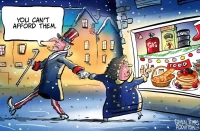December 2007 was the start of the global recession which after 21 months would be termed as the Great Recession. The consensus of a recovery is in doubt in spite of the massive stimulus from USA, Europe, Japan and Canada. Bernanke on 21 July 2010 “warned” Congress that the economic outlook remains unusually uncertain. The global stimulus packages have been between US$ 1.25 and 1.5 trillion; with such massive injection, it was expected that the global economies would recover within 12-18 months and yet there is nothing but grey colors over the economic horizons. Why is the economy sluggish and what’s in it for a recovery by 2011 ? In order to answer the question, we need to look back over the past decade and examine the causes of the great recession and lessons learnt from the previous recessions.
I’ve been a witness to 6 recessions over the past 40 years, but none as worse than this last one. Contraction and expansion cycles are normal phenomena that occur in nature. The global economic crisis, part of a business cycle contraction, was one that essentially went out of control due to various factors, the principal ones being excessive speculation and greed. The warning signs of an economic slowdown were quite visible as early as 2006 and several economists had started to fire warning shots. Hearing the alarm bells, I was beginning to warn privately about the state of the economy.
I was in USA during the recessions of 1969-1970 and 1973-1974 and in Canada during the global recession of 1981-82 that had lasted 16 months.. The latter was mainly because oil prices had begin to spiral from $ 14 in 1978 to $ 40 by 1981-82 due to Iranian revolution and the Iran-Iraq war and the drive by OECD countries to become independent of Middle East oil . Businesses had scurried to find new energy sources in Europe, Canada, USA, Far East and S. America. Business expansion in the energy sector as well as stock market and housing speculation consumed much of the money supply leading up to inflation in the double digit teens. China and India were not part of the economic party then. Though the recovery started in 1984-85 as interest rates eased, full recovery did not occur till the 1991 Gulf War. The trough to peak expansion following that recession was 8 years.
On 29 October 2009, Mark Zandi Chief Economist and founder of Moody’s economy.com in a written statement before the US Congress Joint Economic Committee (JEC) stated that the great recession had finally come to an end in the US primarily due to the fiscal stimulus of $ 787 billion and that the economy was on the road to recovery. The recession had lasted 20 months with nearly 9 million lost jobs. As a result of the fiscal stimulus, the US has eased out of the recession but the unemployment continues at a sluggish 9%. The cause of the recession was an unprecedented global business expansion which included China and India, global credit consumer spending, housing and stock market speculation, oil prices rising from US$ 35 in 2005 to $147 by mid-2008 and the Credit Default Swaps. No wonder, the G7 nations had to inject such massive stimulus to save the economy and prevent a truly global depression.
The US is the economic engine that drives the global economic train. The world has been saving to satisfy the US thirst for consumer goods. 10 months out of a recession and a fragile recovery, there is more than $2 trillion stuck in the economic pipeline of which businesses are sitting on a mountain of $1 trillion. Businesses are unwilling to take the risks to kick start a growth towards recovery due to unusually uncertain circumstances.














Comments